| Published
on 16
Jun
2009 |
All rights reserved.
|
|
|
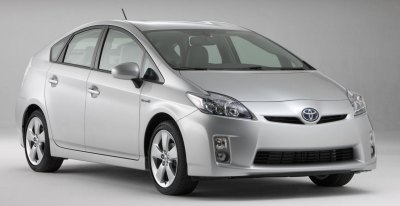
|
Its mission is to extend Toyota's
leadership in hybrid technology and sales...
|
When Toyota launched the
first
generation Prius in December 1997, no one - not even itself - could
tell the prospect of the car. Technology enthusiasts like us applauded
its brave attempt, but none of its rivals, except Honda, took the move
seriously. They did not believe hybrid power vehicles could become
commercially viable. Well, the first generation Prius was really built
at a loss, but its investment was not wasted. Toyota kept improving its
"Hybrid Synergy Drive" system, making it more
efficient and practical. When world oil price started surging in 2004,
the car finally came to its big time. Global sales rocketed from 43,000
units in 2003 to 126,000 units in 2004, then increased steadily to
175,000 units in 2005, 186,000 units in 2006, 281,000 units in 2007...
The Tsutsumi plant struggled to meet booming demand. As of Apr 2008,
its cumulative sales surpassed 1 million units. Its rivals could only
watch Toyota dominating the market and earning serious profit. All the
hard work paid off !
Such success drove many rivals to join the battlefield. Most of the
world's major car makers are working on hybrid cars. In particular,
Honda Insight and Chevrolet Volt are dedicated hybrid models like
Prius. Toyota cannot rest on its laurel. Fortunately, the third
generation Prius has been launched at this critical moment. Its mission
is to extend Toyota's leadership in hybrid technology and sales.
The first thing you notice about the new Prius is a sharper exterior
design -
the windscreen is set at a faster angle, the head and tail lights are
more aggressively shaped, the shoulder lines more sharply pressed into
the sheet metal and the front bumper gets squarer. For the first time
ever, the styling of Prius can be linked to the word "Sporty". However,
on the down side you may say its proportion is somewhat unbalanced, as
all the busy details concentrate on the upper half of the car. Besides,
the sportiness brings it visually closer to other Toyota models, thus
is no longer as distinctive as before. Considering many people used to
buy Prius for its unique image, losing a distinctive appearance could
have a negative effect to its sales.
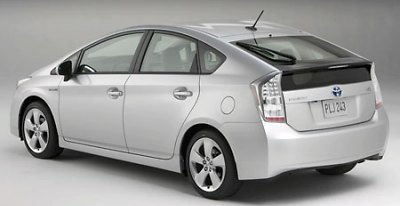
|
Its new-found sportiness may be a
refresh to eyes, but it gets closer to other Toyota models and loses
distinctiveness...
|
However, in
terms engineering, the new car is definitely a vast improvement from
its predecessor. Its aerodynamic drag coefficient has dropped from 0.26
to 0.25 despite of the sharper looks. Its new Corolla-based platform
has vast improvement in strength and refinement. Torsional rigidity of
the chassis has been increased by a whooping 50 percent. Its layout of
suspensions (strut front and torsion-beam rear) and steering mechanism
(electrically assisted) may seem the same as before, but they have been
tuned to sacrifice less driver appeal. It even offers a sport package
with stiffer suspensions, aggressive 215/45VR17 tires and quicker
steering rack (14.6:1
instead of 17.6:1), something we could not have imagined for the old
generation. All-wheel disc brakes is also new to the Prius.
What it
hasn't changed much is the exterior size, which is only 15 mm longer
and 28 mm wider than Mk2, while wheelbase is virtually unchanged.
As before, the Prius is classified as a mid-size car in USA or
D-segment car in Europe. Its compact exterior size belies its roomy
interior. Vast improvement in build
quality, NVH suppression, equipments and performance should have added
considerable weight, but Toyota has managed to limit that to 80 kg
through extensive use of aluminum parts (bonnet, hatchback, brake
calipers and front suspension axle) and more high-strength steel in the
chassis.
Like Honda Insight, Prius Mk3 refuses to bet its fortune on lithium-ion
batteries. Toyota believes this technology is still too expensive and
might arise safety / warranty issues. For a car selling 300,000 units a
year worldwide, it cannot afford any risks. Therefore
the Mk3 takes a realistic approach and sticks with NiMH (Nickel Metal
Hyride) batteries, although it may get Lithium battery later during its
model
cycle.
However,
this does
not stop it from improving elsewhere. The Hybrid Synergy Drive system,
which consists of AC motors, inverter, control unit and transaxle, is
smaller and 20 percent lighter. As before, Toyota's system employs two
AC motors, a big one for propulsion and a small one for regeneration.
The new propulsion motor is smaller and lighter than before (also
undoubtedly cheaper). Its reduced torque is more than compensated by
stepping up gearing and letting it spins at double speed. Furthermore,
it is made more efficient by a few changes: 1) Its operating voltage
has been increased from 500V to 650V to reduce internal loss; 2) The
motors are now connected to the transaxle through gears instead of
chain to reduce friction; 3) The maximum output of battery pack has
been raised from 26kW (34.8hp) to 27kW (36.2hp). Note that although the
motor is
capable of 80hp, it is the battery that regulates its output.
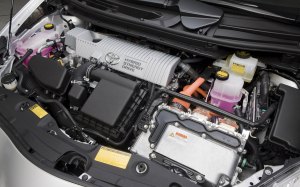
|
More efficient than ever: it emits
just 89 gram of CO2 per km
|
The four-cylinder 16-valve VVT-i engine has also been upgraded.
Capacity has grown from 1.5 to 1.8 liters, and now runs in Atkinson
cycle to enhance thermal efficiency. Maximum output has been increased
to 98 horsepower and 105 lb-ft. Stronger torque means for
most of the time the engine can operate at lower rpm than before, thus
actually improves fuel economy. The new engine has also switched to
on-demand electric water pump to reduce energy consumption.
Combined
output of the
engine and motor is 134hp, up from 108hp of the last generation. 0-60
mph now takes 9.8 seconds, a welcomed improvement of 1 second. However,
the most impressive is still fuel economy. It achieves 50 mpg EPA
combined consumption, 4 mpg higher than the last generation and 9 mpg
better than Mk1. It is easily the most frugal family car in the world,
even compared with the smaller, C-segment Honda Insight and Volkswagen
Golf Bluemotion. See the following table for more details:
aabsssModel
|
US EPA
city/highway
|
EU
combined
|
EU CO2 emission /km
|
Vehicle Class
|
Toyota Prius (195/65R15 tires)
|
51 / 48 mpg
|
72.4 mpg
|
89 g
|
D-segment
|
| Toyota Prius (215/45R17 tires) |
-
|
70.6 mpg
|
92 g
|
D-segment |
VW Golf 1.6TDI
Bluemotion
|
-
|
74.3 mpg*
|
99 g
|
C-segment |
| Honda Insight |
41 / 43 mpg
|
64.2 mpg
|
101 g
|
C-segment |
Volvo S40 1.6D Drive Kinetic
|
-
|
62.7 mpg*
|
118 g
|
C-segment |
Ford
Focus 1.6TDCi Econetic
|
-
|
65.6 mpg*
|
119 g
|
C-segment |
Ford Fusion Hybrid
|
41 / 36 mpg
|
-
|
-
|
D-segment
|
VW Passat 2.0TDI Bluemotion
|
-
|
57.6 mpg*
|
128 g
|
D-segment |
Remark: * diesel has
higher
carbon density than gasoline, therefore a
fair comparison should be made by CO2
emission instead of fuel consumption.
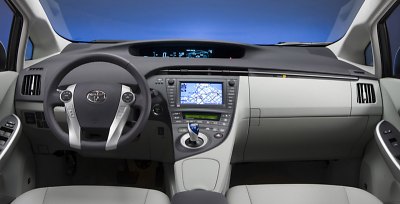
|
A lot of MPVness in the cabin
|
The cabin of Prius is a contrast to its exterior design – there is no
sporty flavours at all, just a lot of MPVness. You sit high in the
cabin as in an MPV. Facing you is an upright steering wheel and a big
piece of grey plastic, both can hardly inspire driving excitement. The
instrument reading is digital and located centrally above the console
in the name of ergonomics. Gear lever is located on a floating console
underneath which is a storage cubby, just like Auris. The front seats
are roomy. The rear seats offer sufficient legroom, thanks partly to
the contoured front seatbacks, but the sloping roof means they are more
suitable to sub-six-footers. This is the price you pay for low
aerodynamic drag. The luggage space is adequately sized, if quite
shallow because underneath which stores the NiMH battery pack, but you
can fold the rear seat flat to increase luggage space.
Build quality seems to be much improved in the cabin. Although all
plastics are not soft-touch, they are richly textured and appear more
expensive than before. The cabin also features a lot of high-tech
equipments to match its advanced image, such as HUD head-up display
(which projects driving information on the windscreen), “Touch Tracer”
controls (when the driver touches the steering-wheel-mounted buttons,
their corresponding functions are displayed on the instrument screen so
that he does not need to move his vision a long way to the steering
wheel), solar-cell roof (which powers ventilation fans to cool the
cabin when the Prius is parked under sunlight), radar cruise control,
automatic parking system, pre-crash system etc.
On
the
road, the new Prius
drives satisfyingly. It doesn’t deliver very strong performance, as its
figures suggested, but the performance is good enough to satisfy most
people’s need. As the electric motor produces instant torque right from
zero rpm, tractability is never a problem. The powertrain is also quite
refined, with imperceptible transition between electric and gasoline
mode.

|
Dynamics are much improved. Far less
sacrifice than before.
|
You can choose among 3 driving modes – EV, Eco or Power. Power mode
unleashes full performance. EV is a pure electric mode which allows up
to 25 mph and 1 mile of range before the battery depleted. In other
words, it is a gimmick. Eco mode, as in Honda Insight, slows down
throttle response and switch to energy-saving strategy for the
planetary CVT to enhance fuel economy. So depending on your mood, the
Prius is normally driven in either Power or Eco mode.
Although the new Prius continues to employ bread-and-butter
suspensions, its ride quality is markedly improved, thanks to the fine
tuning, stronger chassis and better sound deadening. On the roll, there
is far less tire and suspension noise heard in the cabin. Unexpectedly,
the most annoying noise actually comes from wind. At motorway speed,
the mirrors generate quite a lot of noise and the A-pillars fail to
filter it from the cabin.
As for handling, the Prius on standard suspensions is not a big
departure from its predecessor. It still rolls and understeers a lot by
conventional standard. Its steering is still too light and slow to
inspire interest. With Sport package equipped, it is a lot better. Body
roll and understeer are as well contained as most other Toyotas.
Roadholding is more decent. Steering is reassuringly weighted and
satisfyingly quick, if not really communicative. The disc brakes are
more powerful than before, and pedal feel becomes less artificial. You
do sacrifice a little ride comfort and 1.8 mpg of fuel economy, but the
price of sport package is worth paying. That said, don’t confuse the
Prius with a driver’s car. It just gets close to the average level of
conventional family cars, so any comparisons with Ford Mondeo or Mazda
6 are just waste of time.
Anyway, as a green car the new Prius is virtually unbeatable. Until
electric cars or plug-in hybrid cars (like Chevrolet Volt) have got
into mass production, I doubt any cars with 4 proper seats could better
its fuel consumption and emission. Most important, to achieve its green
credential, the new Prius sacrifices little in practicality, comfort
and dynamics. Those rejecting the previous Prius may start thinking
again. For sure, it is the best hybrid power cars currently available. |
Verdict:     |
| Published on 28
May
2011 |
All rights reserved.
|
|
Prius α / Prius V / Prius+
|
|
With global sales passed
the 400,000 units mark in 2009 and the half-million mark last year,
Toyota Prius continues to surprise many observers. But how high is the
sky? Anything must have a limit. To keep fueling the growth, Toyota
knows it has to broaden its appeal, offering more derivatives to lure
those never consider to buy the Prius. This results in the MPV version
reviewed here.
If I were Toyota, I would simply call the car Prius MPV to deliver a
clear message of what the car is. However, since the marketing guys at
Toyota have nothing to do, they play with names. In Japan, they call it
Prius α (alpha). In America, they call it Prius V, where V stands for
Versatility. In Europe, the same car is badged as Prius+. They did not
explain why the car needs different names on different markets. Anyway,
it is meaningless to search for a meaningless answer.
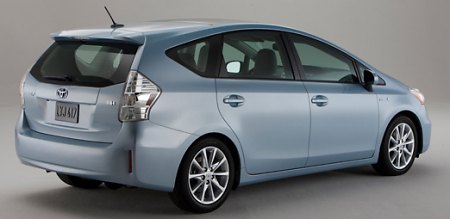
Compare with Prius, the MPV version is inevitably larger – some 155 mm
longer and 30 mm wider. Its wheelbase has been stretched for 80 mm,
enough to accommodate two extra seats. The car is also significantly
taller at 1575 mm. Moreover, the roof line is less swoopy than the
Prius. This makes possible for a third-row seats and a theatre-style
seating arrangement (i.e. the second-row is positioned higher than the
front-row, ditto the third-row against the second-row) to give better
visibility for all occupants. The cabin is definitely roomier, with
more head and shoulder room all round. The boot is 50 percent larger
than the standard Prius.
Like most MPVs, the seating arrangement is flexible. The second row
seat is 60/40-split, can slide individually back and forth to alter the
space between passenger legroom and cargo room, or simply fold flat to
maximize load bay. It also has reclining seatbacks and an integrated
center arm rest, though the latter make the middle seat too hard and
uncomfortable for long journey.
The third row of seats are optional to the Japanese and European
version but absence in the American version – understandably, they are
too small for the taste of American. Even for Japanese, they are not
suitable to adults.

One major difference between the 5-seat and 7-seat versions is the
position of battery pack. In the 5-seat version, it is located under
the boot floor just like the regular Prius. In the 7-seater, that space
is occupied by the rearmost seats and their footwell, so the battery is
moved to the central tunnel located between the front seats. Is that
space big enough ? No, not for the 5-seater's NiMH battery pack, so the
7-seater has to use a more expensive Li-ion battery pack, whose higher
power density means less space is required to give the same
kilowatt-hour. That said, it still comes at the expense of some storage
space. If you don't really need the extra seats, always stick to the
5-seater.
The rest of the cabin is familiar, despite of an updated center-console
instrument panel and the availability of a polycarbonate panoramic
roof. We still cry for more style and higher quality materials. On the
plus side, the heavily bolstered front seats are very supportive.
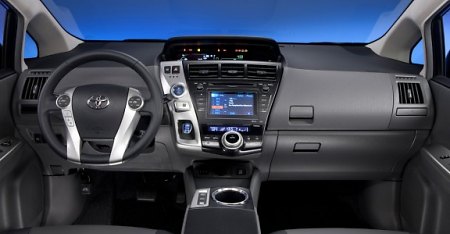
That is quite ridiculous. The Prius MPV is not sporting at all, even
less so than the standard Prius. Disappointingly, even though it gains
105 kg, a higher drag (Cd increased from 0.25 to 0.29) and a larger
frontal area, its underpinnings is left unchanged, which means it still
runs the same 1.8-liter Atkinson cycle engine and electric motor to
produce a combined 134hp. A shorter final drive ratio is chosen to
compensate for the increased weight, but still 0-60 mph takes more than
10 seconds. That final drive ratio also contributes to a considerably
higher fuel consumption. EPA figures deteriorate from the Prius' 51
mpg city, 48 mpg highway and 50 mpg combined to 44 mpg, 40 mpg and 42
mpg respectively. That means a consumption increased by 20 percent.
On the road, not only the car feels slow, but its handling is as dull,
if not duller, than the Prius. The steering is still lifeless. Body
control and braking are not too bad though, thanks to improved damping
and larger brakes. Ride quality is generally good, but refinement is
let down by excessive wind noise from the A-pillars.
Use it purely as a family car, the Prius α / Prius V / Prius+ is
unlikely to disappoint too much. However, compare with the best diesel
MPVs on the market, its slim advantage in fuel economy is not
sufficient to compensate for its weak dynamics. As a result, the
standard Prius still makes more sense.
|
Verdict:    |
|